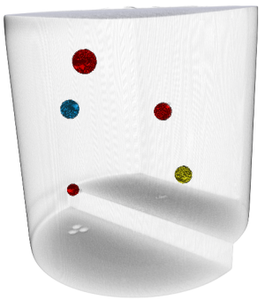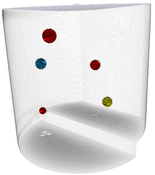Information
- Publication Type: Master Thesis
- Workgroup(s)/Project(s):
- Date: June 2011
- First Supervisor: Eduard Gröller
Abstract
Casting is a manufacturing process by which melt is poured into a mould and then allowed to solidify. Due to the pouring process as well as during solidification casting defects like shrinkage, pores or cracks may appear that can influence the cast objects' mechanical properties and usability. Designing a new type of casting always requires the production of a new pattern first. Before release of serial production a series of initial samples is created. During this evaluation step possible problems are identified that may occur for example due to the mould layout. In the course of this master's thesis effort, a new approach for first article inspection is introduced. The goal of this approach is to explore a series of industrial CT volumes, with the objective to evaluate the casting design. Using the pipeline investigations of the reliability of the production can be performed. The variability analysis is based on a segmentation approach for defect detection which enables to differentiate discontinuities from the rest of the volume In case regions of high defect concentration should be identified, a clustering approach is applied to all samples within the series. The input data set used for clustering consists of the defects' centres of gravity. This way the clustering algorithm can be applied to a set of data points in 3D space. In the further course the cluster information is used to analyse the variability of the sample series, since they represent regions of high defect concentration. The analysis of large defects, in contrast, directly operates on the data produced by the defect detection stage. The data of all samples is compared to find possible overlaps. For the variability analysis it is important to know whether regions can be found that contain defects in more than one trial sample. The identification of such regions shows that the casting process tends to produce errors in certain parts of the object.Additional Files and Images
Weblinks
No further information available.BibTeX
@mastersthesis{schmidt-2011-mt,
title = "Interactive Variability Analysis for Initial Sample Testing
of Industrial CT Data",
author = "Johanna Schmidt",
year = "2011",
abstract = "Casting is a manufacturing process by which melt is poured
into a mould and then allowed to solidify. Due to the
pouring process as well as during solidification casting
defects like shrinkage, pores or cracks may appear that can
influence the cast objects' mechanical properties and
usability. Designing a new type of casting always requires
the production of a new pattern first. Before release of
serial production a series of initial samples is created.
During this evaluation step possible problems are identified
that may occur for example due to the mould layout. In the
course of this master's thesis effort, a new approach for
first article inspection is introduced. The goal of this
approach is to explore a series of industrial CT volumes,
with the objective to evaluate the casting design. Using the
pipeline investigations of the reliability of the production
can be performed. The variability analysis is based on a
segmentation approach for defect detection which enables to
differentiate discontinuities from the rest of the volume In
case regions of high defect concentration should be
identified, a clustering approach is applied to all samples
within the series. The input data set used for clustering
consists of the defects' centres of gravity. This way the
clustering algorithm can be applied to a set of data points
in 3D space. In the further course the cluster information
is used to analyse the variability of the sample series,
since they represent regions of high defect concentration.
The analysis of large defects, in contrast, directly
operates on the data produced by the defect detection stage.
The data of all samples is compared to find possible
overlaps. For the variability analysis it is important to
know whether regions can be found that contain defects in
more than one trial sample. The identification of such
regions shows that the casting process tends to produce
errors in certain parts of the object.",
month = jun,
address = "Favoritenstrasse 9-11/E193-02, A-1040 Vienna, Austria",
school = "Institute of Computer Graphics and Algorithms, Vienna
University of Technology ",
URL = "https://www.cg.tuwien.ac.at/research/publications/2011/schmidt-2011-mt/",
}




